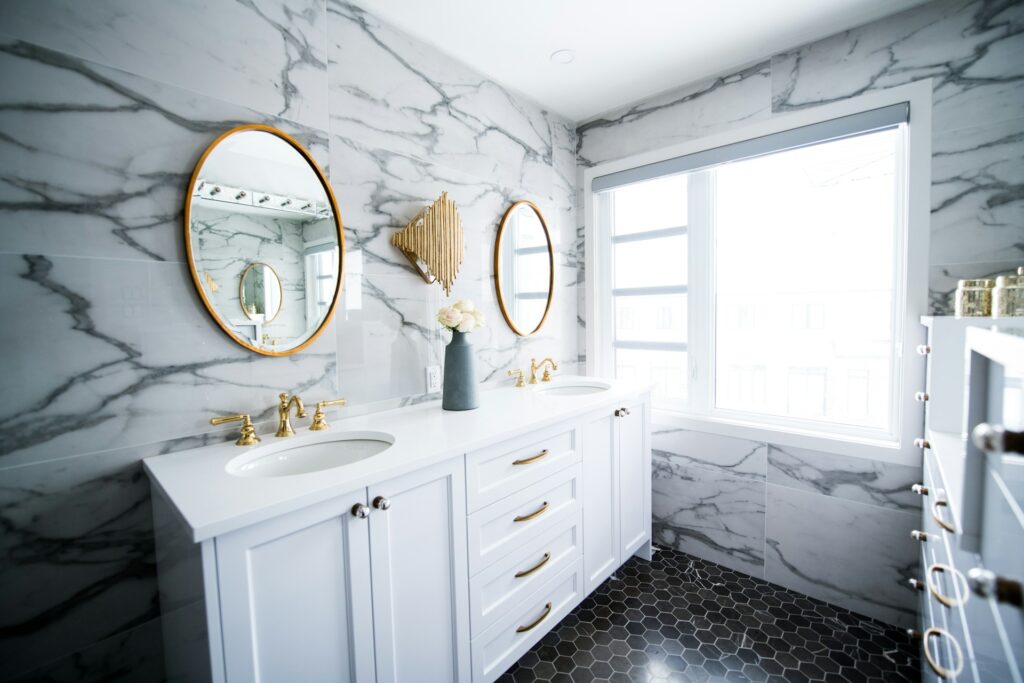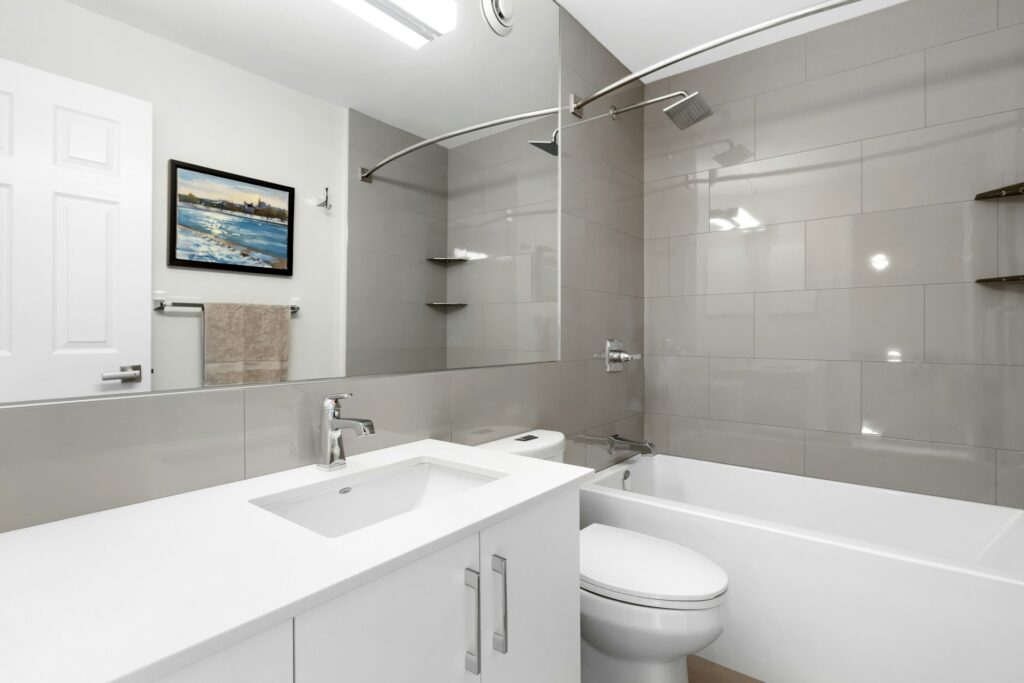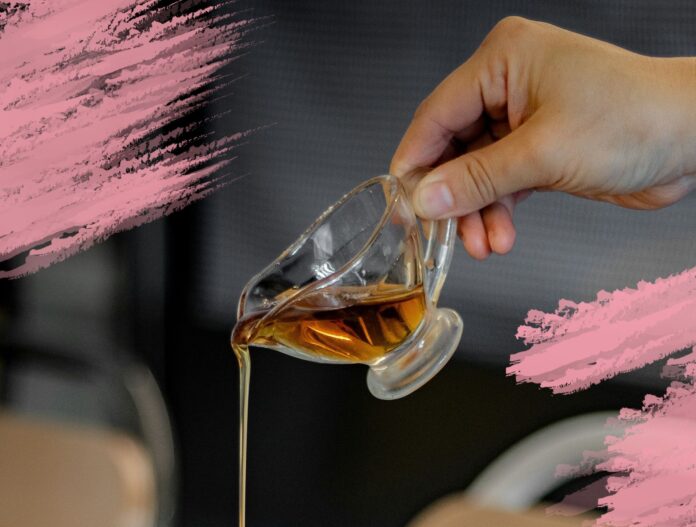It’s only natural that most people want to stay in the house that they’ve built, nurtured and loved well into their retirement and beyond. But as our bodies, brains and needs change, so do the demands we put on our properties.
Often, our homes need updating to meet those changing needs, but this presents something of a conundrum as we age; do we update now, and allow superfluous elements into the home prematurely? Or, do we wait until the necessity for a stairlift, solar light or riser-recliner chair arrives, at which point the willpower to install one may no longer be there?
Today, we’re taking this conundrum into the bathroom, to sit with it a while and contemplate renovations you can make now that will help you live more comfortably as you age. Fortunately, you don’t need to compromise on style or functionality when it comes to future-proofing your bathroom; here are some key ways to do just that.
Install A Walk-In-Shower Or A Wet Room
Wet rooms aren’t just popular with the elderly. In fact, they are becoming a coveted asset to any bathroom, offering a spa-like showering space and an easy-to-clean floor, all in one. As Living reports, “Wet rooms are becoming increasingly popular in the UK, and with their spa-like looks they’re also a great way to add value to your home.’’
Wet rooms are essentially shower spaces that have no shower tray to step over and are at the same level as the bathroom floor. As such they allow accessibility for wheelchairs, and bars or rails can easily be installed to provide stability for those less stable on their feet. Just be sure you install some slip-resistant flooring, wood panelling or mats, as they can get seriously slippery without.

Underfloor Heating
We know installing underfloor heating is a messy job. However, this article is about future-proofing; do it now, and you’ll reap the benefits later in life. Scratch that, you’ll reap the benefits shortly, too.
Indeed, being able to enjoy the luxury of a warm bathroom floor during the cold winter is a real luxury, making cold winter mornings much easier to deal with, and the feeling under bare feet is one of reassurance and comfort, every single time. For those in their later years, such simple comforts can be especially important, when joints and limbs tend to suffer from the cold more.
The beauty of underfloor heating is in the fact that you don’t have to give over valuable wall space to radiators, saving space for a seat and grab bars should you need to add them later on in life. Of course, if you’re renovating your entire home with accessibility in mind, you might consider investing in the best quality products including central heating radiators specifically designed for bathrooms with safety features like low surface temperatures and sleek profiles.
Should you be wondering how much underfloor heating costs, you’ll be happy to hear that it won’t break the bank. The average cost of the parts and installation comes in at around the £1000 mark and there are plenty of styles to choose from.
In the spirit of future-proofing, you’ll likely want a non-slip surface for your bathroom floor and for that, porcelain is the best. Moreover, it’s best to look for tiles with an R13 rating, which is the highest of the slip resistance scores for anti-slip floor tiles.

Non-Slip Tiles
Indeed, when it comes to future-proofing your bathroom, perhaps the most crucial step is literally under your feet. Non-slip tiles are the unsung heroes of a safe and secure bathroom environment; the foundation upon which all other bathroom safety features are built.
Imagine stepping into your bathroom on a chilly morning. The last thing you want is to slip on a wet tile. Non-slip tiles are designed to provide that extra grip, ensuring your bathroom remains a haven of relaxation, not a hazard zone.
Non-slip tiles aren’t just about safety. They’re also about style. Today’s market offers a plethora of designs, colors, and textures to choose from. Whether you’re a fan of the minimalist aesthetic or prefer a more traditional look, there’s a non-slip tile that matches your taste.
Non-slip tiles are also incredibly durable. They’re designed to withstand high levels of moisture and heavy foot traffic, making them a cost-effective solution for those looking to future-proof their bathrooms.
So, how do you choose the right non-slip tiles for your bathroom? Look for tiles with a high slip-resistance rating. These tiles have a slightly rough surface that provides traction even when wet. Also, consider the size of the tiles. Smaller tiles mean more grout lines, which can provide additional slip resistance.
A Walk-In Tub
Here at IDEAL, we love a bath. You know, those long, languid ones that take you somewhere else entirely. Those ones are often bolstered by a book and a bottle (a glass, sorry, we mean a glass), and last until your fingertips are wrinkled and your face flushed. But we digress…
It’s a simple pleasure that sadly seems to get less accessible as we age, since it becomes more difficult to get in and out of the bath. As such, when renovating your bathroom, consider installing a walk-in style tub.
Basins
For further bathroom accessibility additions, consider a wall-mounted basin. Not only do they look stylish, but they also allow for a stool to be placed underneath it, which you can use to clean your teeth, apply makeup and even shave while seated.
You don’t need to stick to a boring white one either; a wall-mounted basin with an intricate, even ornamental design can really lift the aesthetic value of the space. To make one a proper focal point, and a piece of art in the process, consider installing a ceramic, tiled version, seen across Greece, Turkey, and the Middle East, as well as East Asia. Just gorgeous, and timeless, too – talk about future-proofing!

A Thermostatic Shower
We’ve all been in the shower when suddenly, there’s a drop in water and it either becomes freezing cold or scalding hot. By adding a thermostatic shower mixer to better control the temperature in your shower, you can be assured that those horrific sudden scalds of heat or bracing cold changes when someone else in the house turns on a tap are a thing of the past.
Why will this help you in the future? Thermostatic mixer showers are ideal for the elderly as they prevent sudden changes in temperature, which means a safer, more secure shower. Which is the least we can offer our more elderly selves, don’t you think?
Read: How robots can help you around the house
Accessible Storage Solutions
When it comes to future-proofing your bathroom, storage is often overlooked. Yet, as we age, the ability to reach high shelves or bend down to retrieve items from low cupboards can become increasingly difficult. Consider installing pull-out drawers and shelves at waist height, eliminating the need to stretch or stoop. Wall-mounted cabinets with sliding doors require less space to operate than traditional swing doors, making them ideal for wheelchair users or those with limited mobility.
The beauty of implementing these storage solutions now is that they’re not only practical for later life but also incredibly convenient at any age. Soft-close drawers, touch-release mechanisms and strategically placed handles all contribute to a bathroom that’s both stylish and accessible. Look for moisture-resistant materials like treated wood or high-quality laminate that will stand the test of time, ensuring your investment remains functional and attractive for decades to come.

Proper Lighting Design
Lighting isn’t merely an aesthetic consideration when future-proofing your bathroom; it’s a crucial safety feature. As our eyesight naturally deteriorates with age, adequate lighting becomes increasingly important. Consider a layered lighting approach that combines ambient, task and accent lighting to eliminate shadows and dark spots where accidents might occur.
Motion-sensor lights are particularly useful for night-time visits to the loo, automatically illuminating your path without requiring you to fumble for switches in the dark. Meanwhile, illuminated mirrors can provide focused light for tasks like shaving or applying makeup, reducing eye strain.
For maximum accessibility, position switches at a comfortable height and consider opting for rocker or touch switches rather than traditional toggle versions, which can be challenging for those with limited dexterity. LED options not only provide superior brightness but are energy-efficient and long-lasting—meaning fewer bulb changes in years to come, a practical consideration for when climbing stepladders becomes less appealing.Retry
The Bottom Line
Designing your bathroom now, while thinking about what’s to come, makes good financial sense. But more than that, it grants a little peace of mind about your golden years being as comfortable and contented as possible.
And whilst you’re here, considering the convenience and security of your home, check out these tips on how to adapt your home to make it more accessible.





